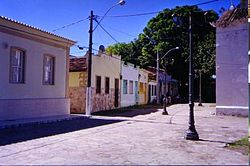Itaparica | |
|---|---|
 A street in Itaparica. | |
 Location in the state of Bahia and Brazil | |
| Coordinates: 12°53′16″S38°40′44″W / 12.88778°S 38.67889°W | |
| Country | Brazil |
| Region | Northeast |
| State | Bahia |
| Government | |
| • Mayor | Marlylda Barbuda dos Santos |
| Area | |
• Total | 115.922 km2 (44.758 sq mi) |
| Population (2020, est. [1] ) | |
• Total | 22,337 |
| • Density | 190/km2 (500/sq mi) |
| Time zone | UTC−3 (BRT) |
| Website | Prefeitura Municipal de Itaparica |
Itaparica is a municipality located in the Brazilian island of the same name in the state of Bahia. The municipality covers 13% of the island; the remainder belongs to the municipality of Vera Cruz. The municipality of Itaparica has a population of is 22,337 (2020 estimate) and covers an area of 115.922 square kilometres (44.758 sq mi).

